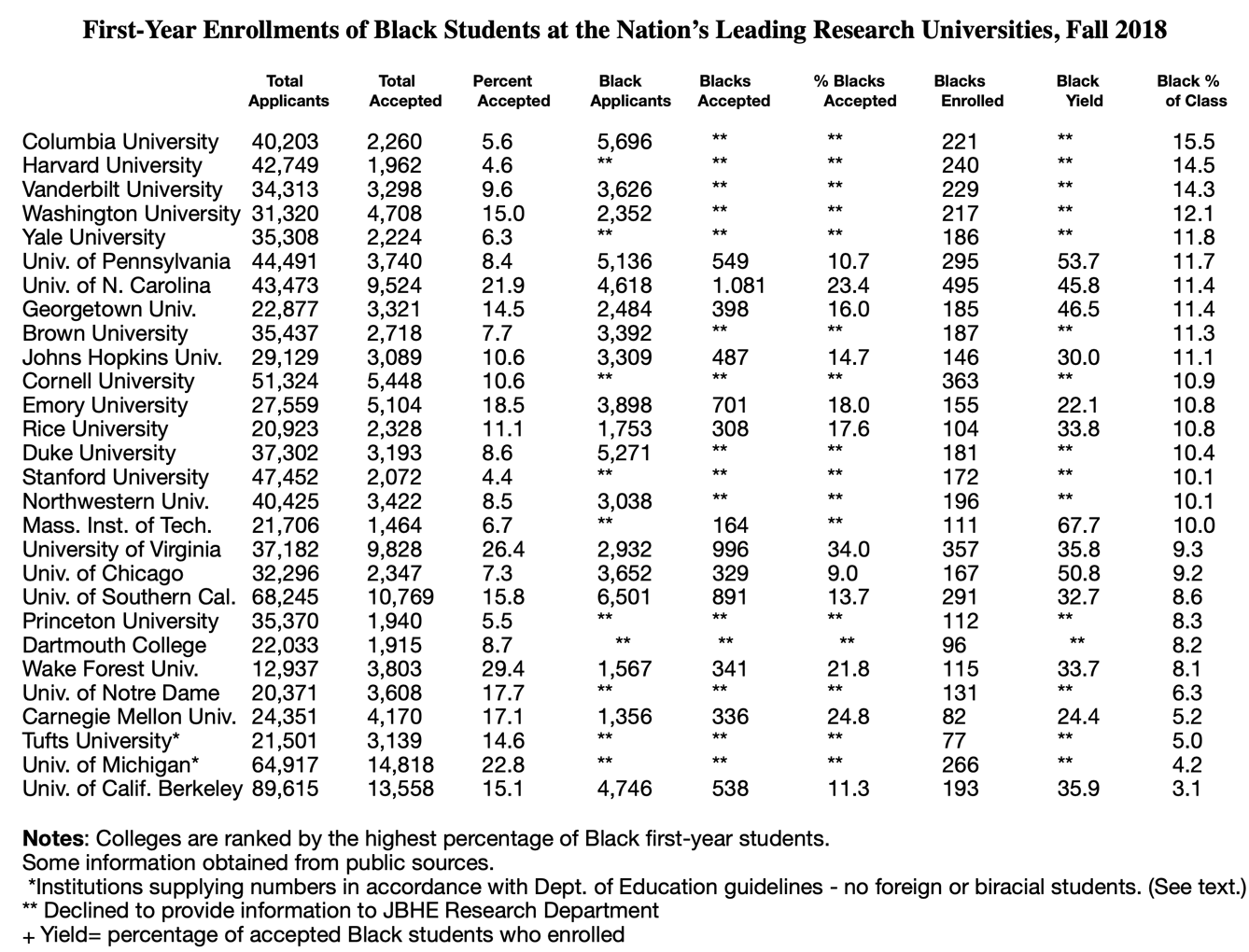![]() Once again, this year The Journal of Blacks in Higher Education has completed its survey of admissions offices at the nation’s highest-ranked research universities. For the 26th consecutive year, we have calculated and compared the percentages of Black/African-American students in this fall’s entering classes. As in the past, our survey publishes information on the total number of Black applicants at the various institutions, their acceptance rates, enrollment numbers, and yield rates (the percentage of students who eventually enroll in the colleges at which they were accepted).
Once again, this year The Journal of Blacks in Higher Education has completed its survey of admissions offices at the nation’s highest-ranked research universities. For the 26th consecutive year, we have calculated and compared the percentages of Black/African-American students in this fall’s entering classes. As in the past, our survey publishes information on the total number of Black applicants at the various institutions, their acceptance rates, enrollment numbers, and yield rates (the percentage of students who eventually enroll in the colleges at which they were accepted).
In 2004, Blacks made up only 6.8 percent of the entering students at Columbia University in New York City. Columbia ranked 15th among the high-ranking research universities in our survey that year. Just three years later in 2007, Columbia University headed the JBHE rankings for the first time with an entering class that was 11.4 percent Black. In 2010, there were 202 Black first-year students at Columbia. They made up 14.5 percent of the incoming students. At that time, his was the highest percentage of Black students in the entering class at a leading research university in the history of the JBHE survey. For nine years in a row, Columbia had the highest percentage of Black first-year students among the 30 highest-ranking universities in the nation. Two years ago, Columbia finished in a virtual dead heat for first place but was narrowly edged out by Washington University for the top spot. Again in 2017, Columbia finished in second place with an entering class that was 13.9 percent Black.
In 2018, Columbia University once again sits atop the JBHE rankings. This year there are 221 Black students in the entering class. They make up 15.5 percent of the first-year students. This is the highest percentage of Black students in the entering class of a major research university in the 26 years of the JBHE survey.

Harvard University has an entering class that is 14.5 percent percent Black, which places the university second overall and second in the Ivy League. As was the case for the past two years, Harvard has a record high percentage of Black students in its first-year class.
Last year, for the first time in the quarter-century history of our survey, Vanderbilt University in Nashville, Tennessee, had the highest percentage of Black students in its entering class of any of the high-ranking research universities in our survey. There were 226 Black first-year students at Vanderbilt, making up 14.1 percent of the entering class. This year, the Black percentage of the entering class edged up to 14.3 percent but Vanderbilt dropped to third place in the overall rankings.
Four years ago, there were 84 Black students in the entering class at Washington University in St. Louis. They made up only 4.8 percent of the entering class. Only two high-ranking research universities had a lower percentage of Black students in their first-year classes. By 2015, there were 159 Black students in the entering class, making up 9.2 percent of all first-year students. At that time admissions officials told JBHE that “our number is still relatively small and we hope to continue to make progress as our efforts expand further.” They have made good on that promise. Two years, there were 221 Black students in the entering class, making up 12.4 percent of all first-year students. This placed Washington University in first place overall. Last year, Washington University slipped to eighth place overall, due to a drop of more than 11 percent in Black first-year students. However, Blacks still made up a very respectable 11 percent of the entering class, more than double the percentage from four years ago. This year, Washington University has moved back up to take fourth place in our survey with an entering class that is 12.1 percent Black.
Rounding out the top 10 are six research universities that have entering classes that are more than 11 percent Black. They are: Yale University, the University of Pennsylvania, the University of North Carolina, Georgetown University, Brown University and Johns Hopkins University.
Another seven highly ranked universities have entering classes that are at least 10 percent Black. In 2004, only two of the nation’s highest-ranked universities had incoming classes that were more than 10 percent Black. This year there are 17 high-ranked universities with an entering class that is more than 10 percent Black. This is an all-time record for our survey. In 2018, four high-ranking universities have an entering class that is at least 12 percent Black. In 2004, there were none. These figures are a major sign of progress for African Americans at our top universities.
The progress of the Ivy League schools over the past decade in admitting Black students has been impressive. In 2006, Columbia University had the highest percentage of Black first-year students at 9.6 percent. This year, six of the eight Ivy League schools have entering classes that are 10 percent Black or higher. In 2006, the lowest percentage of Blacks in an entering class was 5.9 percent. This year it is 8.2 percent. In 2006, there were 1,110 Black students in the entering classes at the eight Ivy League schools. In 2017, there are 1,700, a 53 percent increase.
The two universities at the lower end of the rankings are public institutions in states that have laws prohibiting the consideration of race in college admissions. The University of California, Berkeley is at the bottom of the list with an entering class that is 3.1 percent Black. The percentage of Black first-year students at Berkeley remains significantly below the level of Black enrollments that existed before that state enacted a ban on race-sensitive admissions.
The same is true at the University of Michigan. There, Blacks make up 4.2 percent of the students in the first-year class.
Gainers and Losers

We have data on first-year enrollments of Black students at 26 high-ranking research universities for both 2017 and 2018. Sixteen showed gains over the previous year in Black student first-year enrollments. Ten high-ranking universities showed declines in their number of entering students who are Black. It must be noted that gains or declines in the number of first-year Black students at some universities may be due to overall increases or decreases in the size of the first-year class and not necessarily due to a higher or lower percentage of Black first-year students.
Last year, Princeton University led the list. It had 147 Black students in its entering class, up from 102 in 2016. This was a gain of 44 percent. This year, Princeton has 112 Black students in its entering class, which places Princeton at the bottom of the list, with a 23.8 percent decline.
Brown University in Providence, Rhode Island, had the largest percentage increase this year. There are 187 Black first-year students at Brown. This is up 21.4 percent from a year ago.
Other high-ranking universities that show a double-digit percentage increase in Black first-year enrollments are the University of North Carolina at Chapel Hill, Columbia University, Emory University, and Washington University.
In addition to Princeton, the only other major high-ranking research universities to post a decline of more than 10 percent in Black students in their first-year classes are Duke University, Carnegie Mellon University, and Dartmouth College.
A Note on Methodology
Before we continue with the results, it is important to mention how the U.S. Department of Education collects data on the race of undergraduates. Before a change was made several years ago, students who reported more than one race (including African American) were included in the figures for Black students. This is no longer the case. Thus, students who self-identify as biracial or multiracial with some level of African heritage are no longer classified as Black by the Department of Education.
JBHE surveys have always asked respondents to include all students who self-identify as having African American or African heritage including those who are actually from Africa. JBHE has always maintained that biracial, multiracial, and Black students from Africa add to the diversity of a college campus. And including these students in our figures offers college-bound Black students a better idea of what they can expect at a given college or university. In order that we can compare our current data to past JBHE surveys we have continued to asked colleges and universities to include all students who identify themselves as having African American or African heritage.
Caution: Some universities that participate in our survey choose to adhere to Department of Education guidelines and report figures for African American students only and do not include African, biracial, or multiracial students in the figures reported to JBHE. These institutions are indicated by an asterisk in the accompanying table. Undoubtedly, the percentage of Black students at these research universities would be higher – sometimes significantly so – if they included African, biracial, and multiracial students.
Black Student Acceptance Rates
It is well recognized that the percentage of Black applicants who actually receive invitations to join the entering class is a valuable gauge of an institution’s commitment to racial diversity. Yet this figure is regarded as the most sensitive of all admissions data. This is particularly true for some of the very highest-ranked institutions.
We note that this year there appears to be an even greater reluctance to divulge information about Black student acceptance rates than in the past. The recent litigation involving the admissions practices of Harvard University concerning Asian American students appears to have struck a nerve in higher education circles. Colleges and universities increasingly seem to want to hold their cards close to their vests and not add fuel to efforts to challenge affirmative action admissions policies.
Unquestionably, public and private litigation threats to affirmative action policies in college admissions have been a factor in producing this sensitivity. With this in mind, admissions officers — who, we believe, on the whole are solidly supportive of affirmative action — have apprehensions when statistics on Black admissions are made available to the public. There are standard concerns too that racial conservatives on faculties and among alumni and trustees may interpret the figures as suggesting a so-called dumbing down of academic standards and a favoring of “unqualified” Blacks over perhaps more qualified Whites.
Of the 27 highest-ranked universities for which we have data on Black students in their entering classes, we have Black acceptance rate statistics for only 12 universities.
At eight of the 12 universities that supplied acceptance rate data to JBHE, the Black student acceptance rate was higher than the acceptance rate for all students. In the past the differences in acceptance rates at some universities were quite large. But now, the differences are usually very narrow. Again, this may reflect a concern over the threat of litigation if there is a perception that a particular racial or ethnic group is receiving an edge in the admissions process.
Of the 13 universities that reported Black student yield, the highest rate was at the Massachusetts Institute of Technology. At MIT, 67.7 percent of all Black students accepted for admission decided to enroll. Among the reporting universities, the University of Pennsylvania ranked second in Black student yield with a rate of 53.7 percent. The University of Chicago also reported a Black student yield of over 50 percent. Traditionally Harvard University and Stanford University have had the highest Black student yields. But in recent years, Black student yield at these high-ranking institutions was not made available to JBHE.












I am sorry not to see the University of Virginia in this Annual Survey, Black Alumni should find out why. For the past 10 year or more UVA has appear in this survey.
Our daughter is a sophomore at Brown. During our 4 or 5 visits to the campus over the 1.5 years she has been there, we are always amazed at what seems to be a large number of AA students in particular and non-white (other than Asian students) in particular. It is FAR more than the 2.5% in her high school and she is THRIVING. So, so glad that she’s found the right place for her at this stage in her development. And the idea that Brown’s numbers have grown Year-over-year is a good thing too. I really appreciate JBHE for all that you do and I need to share it with more people. Please keep up your excellent work!
It would be helpful to include figures for percentages of Black students who actually get their degrees at these institutions. If a school admits students but does not make sure that they thrive, that is not real progress. I would hope that the completion percentages are high, but the data is not readily available.